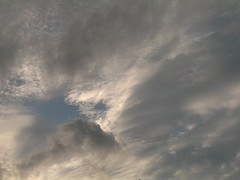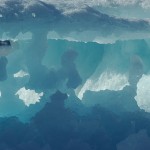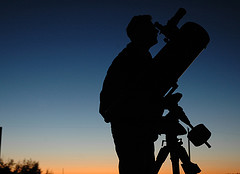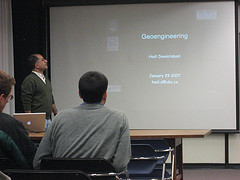helping you to navigate SciEng information
August 25th, 2009 by Eugene Barsky | No Comments »

I have posted about climate engineering before. Here is the new article from the last issue of Science that discusses the risks of climate engineering – “Risks of Climate Engineering”
Risks of Climate Engineering
Gabriele C. Hegerl and Susan Solomon (21 August 2009)
Science 325 (5943), 955. [DOI: 10.1126/science.1178530]
This short opinion article presents the points against temperature changes potentially caused by geoengineering…
** photo by http://www.flickr.com/photos/courambel/
Posted in Atmospheric Science, Chemical and Biological Engineering, Earth and Ocean Sciences, General Science, Geography, Main, Physics | No Comments »
July 20th, 2009 by Eugene Barsky | No Comments »

New Scientist reports about the final draft of the American Meteorological Society‘s carefully worded position paper on geoengineering. The AMS is the first major scientific body to officially endorse research into geoengineering.
From New Scientist:
The document states that “deliberately manipulating physical, chemical, or biological aspects of the Earth system” should be explored alongside the more conventional approaches to climate change. Conventional approaches means reducing emissions – “mitigation” in policy-speak – and adjusting to the unavoidable effect of climate change – known as “adaptation”.
The paper states that “even aggressive mitigation of future emissions cannot avoid dangerous climate changes resulting from past emissions. Furthermore, it is unlikely that all of the expected climate-change impacts can be managed through adaptation. Thus, it is prudent to consider geoengineering’s potential benefits, to understand its limitations, and to avoid ill-considered deployment”.
http://www.newscientist.com/article/dn17490-climate-engineering-research-gets-green-light.html?DCMP=OTC-rss&nsref=online-news
** photo by courambel
Posted in Atmospheric Science, Chemical and Biological Engineering, Chemistry, Earth and Ocean Sciences, General Science, Geography, Main, Materials Engineering, Physics, Uncategorized | No Comments »
July 3rd, 2009 by Eugene Barsky | No Comments »

A very recent article on PLoS One is worth the read –
Bollen J, Van de Sompel H, Hagberg A, Chute R, 2009 A Principal Component Analysis of 39 Scientific Impact Measures. PLoS ONE 4(6): e6022. doi:10.1371/journal.pone.0006022
Abstract:
Background
The impact of scientific publications has traditionally been expressed in terms of citation counts. However, scientific activity has moved online over the past decade. To better capture scientific impact in the digital era, a variety of new impact measures has been proposed on the basis of social network analysis and usage log data. Here we investigate how these new measures relate to each other, and how accurately and completely they express scientific impact.
Methodology
We performed a principal component analysis of the rankings produced by 39 existing and proposed measures of scholarly impact that were calculated on the basis of both citation and usage log data.
Conclusions
Our results indicate that the notion of scientific impact is a multi-dimensional construct that can not be adequately measured by any single indicator, although some measures are more suitable than others. The commonly used citation Impact Factor is not positioned at the core of this construct, but at its periphery, and should thus be used with caution.
Frankly, I was surprised by the authors’ conclusion, particularly with this piece: “Our results indicate that the JIF and SJR express a rather particular aspect of scientific impact that may not be at the core of the notion of scientific “impact”. Usage-based measures such as Usage Closeness centrality may in fact be better “consensus” measures.”
I am used to be inquired about Journal Impact Factor (JIF) so often in academia and know that it used for tenure consideration in many departments in UBC.
** photo by testone 22
Posted in Astronomy, Atmospheric Science, Chemical and Biological Engineering, Chemistry, Civil Engineering, Earth and Ocean Sciences, General Science, Geography, Main, Materials Engineering, Mathematics, Mechanical Engineering, Physics, Podcasts, Science - undegraduate classes, Statistics, Wood Sciences | No Comments »
June 29th, 2009 by Aleteia Greenwood | No Comments »

UBC Engineering student helps collect scientific data for Canada’s Arctic submission to the United Nations
Alexander Forrest, a UBC civil engineering PhD candidate, is part of a team supporting the use of autonomous underwater vehicles (AUVs) to collect scientific data for Canada’s Arctic submission to the United Nations.
Forrest has been working with International Submarine Engineering Ltd. as a support engineer and will assist in AUV operations next year when two AUVs operate thousands of metres under the ice to survey the seabed.
Canada, the U.S., and Denmark are collecting scientific data to establish sovereign rights to parts of the Arctic Ocean under the United Nations Convention on the Law of the Sea. Canada has until 2013 to provide its submission to the United Nations. Russia and Norway have already made submissions to the UN.
More at UBC This Week.
**image by cam17
Posted in Civil Engineering, General Science, Geography, Main, Uncategorized | No Comments »
June 9th, 2009 by Eugene Barsky | No Comments »

Thomson Reuters has released its latest figures for Canadian Science last week – http://sciencewatch.com/dr/sci/09/may31-09_2/
Between 2004 and 2008, Thomson Reuters indexed 226,232 papers that listed at least one author address in Canada. Of those papers, the highest percentage appeared in journals classified under the heading of environment/ecology, followed by psychiatry/psychology and geosciences. As the right-hand column shows, the citations-per-paper average for environment/ecology papers from Canada-based authors was 24% above the world average in the field (5.49 cites per paper for Canada versus 4.43 cites for the world). In fact, in all the fields shown here, the impact of Canadian research exceeded the world average, with particularly strong performance in space science (44% above the world average), physics (43% above), and agricultural sciences (+29%).
It is great to see that we are producing a decent share of world’s research. But it seems that Engineering is one of weak points!
** Photo by tripleman
Posted in Astronomy, Atmospheric Science, Chemical and Biological Engineering, Chemistry, Civil Engineering, Earth and Ocean Sciences, General Science, Geography, Main, Materials Engineering, Mathematics, Mechanical Engineering, News, Physics, Science - undegraduate classes, Statistics, Wood Sciences | No Comments »
May 21st, 2009 by Eugene Barsky | No Comments »

In celebration of the International Year of Astronomy in 2009, New Scientist takes you on an armchair tour of some of the most important telescopes ever built – http://www.newscientist.com/gallery/dn16663-important-telescopes
UBC Library owns dozens of books on telescopes. See some of them here- Telescopes.
** Photo by Space Ritual
Posted in Astronomy, Atmospheric Science, Earth and Ocean Sciences, General Science, Geography, Main, Physics | No Comments »
May 8th, 2009 by Kevin Lindstrom | No Comments »
Statistics isn’t just about bayesian disease mapping and analyzing incomplete multivariate data. Statistics has some very important applications for analyzing hockey – yes, ice hockey. While my team hasn’t made the playoffs for a while except for that glorious 2006 run, it might be interesting to for any of you hockey statisticians to apply the research to the teams currently playing in the NHL playoffs.
Here’s a sample of some the articles available in MathSciNet and Current Index to Statistics dealing with ice hockey.
Thomas, Andrew C. (2007) “Inter-arrival Times of Goals in Ice Hockey,” Journal of Quantitative Analysis in Sports: Volume 3: Issue 3, Article 5. Available at: http://www.bepress.com/jqas/vol3/iss3/5
Thomas, Andrew C. (2006) “The Impact of Puck Possession and Location on Ice Hockey Strategy,” Journal of Quantitative Analysis in Sports: Volume 2: Issue 1, Article 6. Available at: http://www.bepress.com/jqas/vol2/iss1/6
Anthology of Statistics in Sports. Edited by Jim Albert, Jay Bennett and James J. Cochran. ASA-SIAM Series on Statistics and Applied Probability, 16. 2005.
Gill, Paramjit S. (2000) “Late-Game Reversals in Professional Basketball, Football, and Hockey” The American Statistician, Volume 54, Number 2 (May, 2000), pp. 94-99 http://www.jstor.org/stable/2686024
The Journal of Quantitative Analysis in Sports is a great place to browse.
Submitted by Kevin Lindstrom UBC Science and Engineering Librarian
Posted in Amusing stuff, Atmospheric Science, Chemical and Biological Engineering, Chemistry, Civil Engineering, Earth and Ocean Sciences, General Science, Geography, Main, Materials Engineering, Mathematics, Mechanical Engineering, News, Physics, Podcasts, Science - undegraduate classes, Statistics, Uncategorized, Wood Sciences | No Comments »
May 4th, 2009 by Eugene Barsky | No Comments »

Maclean’s has featured an article last week on geoengineering – http://www2.macleans.ca/2009/04/22/plan-b-for-global-warming/
The article focused on work of David Keith from UofC. His main article on geoengineering – “Geoengineering the climate: History and prospect” can be found here (in full text PDF for UBC folks)
A quick search in Web of Science database shows that every year there are twice as many article on this topic than a previous year…
Here are some folks in UBC Applied Sciences that work in this area
** Photo by freedryk
Posted in Atmospheric Science, Chemistry, Earth and Ocean Sciences, General Science, Geography, Main, Mechanical Engineering, News, Science - undegraduate classes | No Comments »
May 1st, 2009 by Kevin Lindstrom | No Comments »
The following 2009 Earth and Ocean Science undergraduate honours theses are available online from cIRcle – UBC Library’s Digital Repository.
- The Diamond Potential of the Tuwawi Kimberlite (Baffin Island, Nunavut). Cross, Jodi
- A pre-feasibility study to assess the potential of Open Loop Ground Source Heat to heat and cool the proposed Earth Science Systems Building at the University of British Columbia Parajulee, Abha; Smet, Kim
- Nature and Origin of Gold-Rich Carbonate Replacement Deposits at the Rau Occurrence, Central Yukon Kingston, Scott P.
- Flow Modeling of a Syncrude North East In-Pit Hummock for the Sandhill Fen in Fort McMurray, Alberta Preston, Ryan
- Asymmetrical Subsidence Resulting from Material & Fluid Extraction Martz, Patrick
- Permeability of Limestone-Dolomite Composite Fracture Surfaces Van de Reep, Peter John
- Humidity Cell Investigation of Particle Size Effects on Weather Rates of Mine Waste Rock from the Antamina Mine, Peru. Yu, Emily
- Relationships between Geology, Ore-body Genesis, and Rock Mass Characteristics in Block Caving Mines Banks, Craig
- Foundation Design of a Shoppers Drug Mart in Squamish, B.C. To, Martin Ho-Nang
- Uranium-Lead Geochronology of Granophyres from the Archean Stillwater Complex, Montana USA)
Corey J.
- Understanding Geological Time: A Proposed Assessment Mechanism for Beginner and Advanced Geology Students at the University of British Columbia, (Vancouver) Rhajiak, Jamil Ahmed Nizam
Submitted by Kevin Lindstrom Liaison Librarian for Earth and Ocean Sciences.
Posted in Earth and Ocean Sciences, General Science, Geography, Podcasts, Science - undegraduate classes | No Comments »
April 24th, 2009 by Kevin Lindstrom | No Comments »
Canada Excellence Research Chairs – Phase 1 Competition Results
Overview
In 2008, the Government of Canada created a new permanent program to establish 20 prestigious research chairs–Canada Excellence Research Chairs (CERC)–in universities across the country. The CERC program invests $28 million a year to attract and retain the world’s most accomplished and promising minds and help Canada build a critical mass of expertise in the priority research areas of environmental sciences and technologies, natural resources and energy, health and related life sciences and technologies, and information and communication technologies.
Phase 1 Competition Results
The following 17 universities have been invited to compete in Phase 2.
Universities invited to Phase 2 competition
(Number of successful proposals arranged from West to East)
* University of British Columbia (4)
* University of Alberta (5)
* University of Calgary (1)
* University of Saskatchewan (1)
* University of Manitoba (1)
* University of Toronto (5)
* University of Waterloo (4)
* McMaster University (2)
* Queen’s University (1)
* University of Western Ontario (2)
* University of Ottawa (2)
* McGill University (4)
* Université Laval (3)
* Université de Sherbrooke (1)
* Université du Québec à Trois-Rivières (1)
* University of Prince Edward Island (1)
* Dalhousie University (2)
Click here for a list of the successful proposals
Submitted by Kevin Lindstrom Liaison Librarian
Posted in About this blog, Amusing stuff, Atmospheric Science, Chemical and Biological Engineering, Chemistry, Civil Engineering, Earth and Ocean Sciences, General Science, Geography, Main, Materials Engineering, Mathematics, Mechanical Engineering, News, Physics, Podcasts, Science - undegraduate classes, Statistics, Teaching, Uncategorized, Wood Sciences | No Comments »
« Newer Posts - Older Posts »







